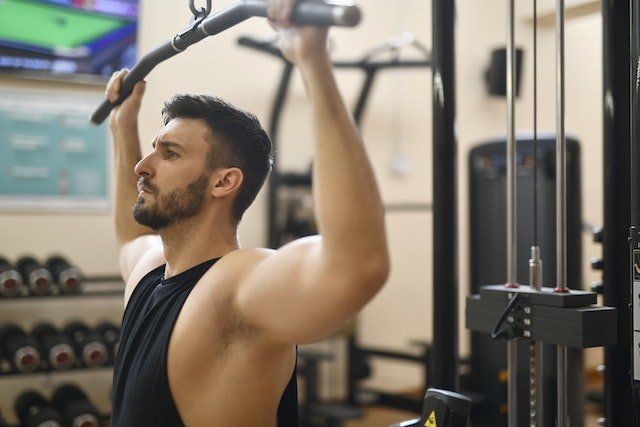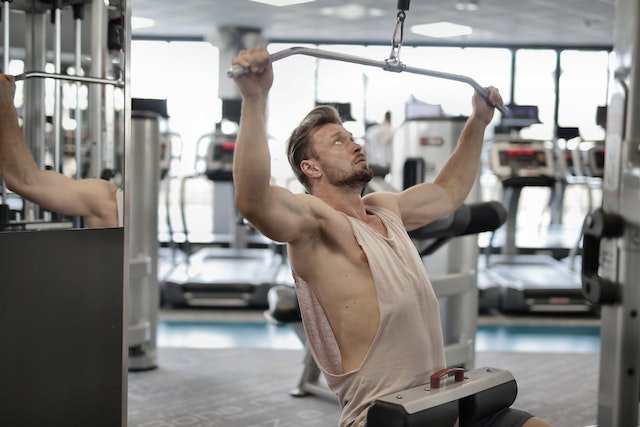
Why Do I Feel Lat Pulldowns In My Chest? Problem Solved For Better Gains
Have you ever trained your back with lat pulldowns, only to feel it afterwards in your chest?
This situation can feel strange, as you should be working your back muscles instead of your pecs.
Normally the feeling of lat pulldowns in your chest can be easily fixed and is nothing too serious to worry about.
Is it just chest tightness or something worse? Keep reading to discover more about why you feel that sensation in your chest and what to do next.
Hopefully, after reading this post you will be able to get back to training your back without feeling it in your chest!
Why do I feel lat pulldowns in my chest?
The primary muscles worked during lat pulldowns are the lats (latissimus dorsi) and the rhomboids. The lower pecs act as stabiliser muscles, meaning they are not working as hard as the lats and rhomboids. However, if you have incorrect form when performing lat pulldowns, you may feel it more in your chest than your back. This is because the pec muscles are being worked harder due to poor form and posture. If you are trying to lift too heavy, or jerking the bar too much, your chest muscles are working more than they should be and this can lead to chest tightness. Gripping the bar too tight while trying to control the load will also engage your pecs more due to the effort required to hold the bar in place. Rushing the movement and having the bar stretch too far over the head can also cause chest tightness to occur. Another potential reason why you may feel lat pulldowns in your chest is from training your chest before your back. If you are overtraining one muscle group and then going straight into another, you may be tiring out the chest muscles before you have even started your back workout. This can lead to chest tightness and feeling lat pulldowns in the chest.
Let’s now look more in-depth at the reasons why you might be feeling lat pulldowns in your chest and what you can do to resolve the issue…
Stabilisers
The lower pec muscles act to keep the load stable during lat pulldowns and are not worked as hard as the lats and rhomboids.
However, incorrect form can cause these muscles to be worked harder than they should be, leading to chest tightness.
Stabiliser muscles work best when the load is evenly distributed across the body so that only the working muscles are activated. To avoid chest tightness during lat pulldowns, ensure that the load is not too heavy and that you are using the correct form and posture.
Make sure that your core is engaged and you are keeping your shoulders back. This will ensure that the lower pecs remain as stabilisers and do not overwork during the movement.
Grip width and type
Having the correct grip width is important when performing lat pulldowns to ensure that you are using the correct form and posture. Depending on the grip width you have will determine which muscles get worked more or less.
If you use a narrow grip, you are likely to be working your lats and biceps more but can feel uncomfortable if you are using an overhand grip.
If you use a wide grip while doing this exercise, it will target the rhomboids more along with the lats. The movement will feel more natural, but keep in mind that you might not be able to lift as much weight because of the increased leverage.
The type of grip you have on the bar can also make a massive difference. If you are using an overhand grip, you are likely to feel more chest tightness due to the increased effort needed to hold the bar in place.
To avoid feeling lat pulldowns in your chest, you could try using an underhand grip. This will allow you to keep the bar more stable and may help reduce chest tightness.
There are quite a few different variations of grip widths and types to take into consideration. For example, you could have a narrow underhand grip or a wider overhand grip.
Let’s not forget that you can use a neutral grip if you can find the right handle (one off seated cable row), this will make the exercise feel different once again, it all depends on what works best for you and your body.

Grip on bar
Having a strong grip on the bar, whatever the type of grip or width can also lead to chest tightness.
When you grip something hard and for long periods, the muscles of your hands, forearms and even upper arms can become tight. This can lead to strain in the chest which could be why you are feeling lat pulldowns in your chest, especially if the load is too heavy.
To resolve this issue, make sure you are not gripping the bar too tightly and that you are switching between different grip types throughout your workout.
When you are using an overhand grip it is important to ensure that the bar is not too thick. If the bar is too thick, it will be harder to hold on to and this can cause your lower pecs to become overworked.
If you use an underhand grip, make sure the bar is not too thin as it can cause you to grip the bar too hard.
It is important to find the right bar that has just the right thickness and width for your body and grip strength. This will help to minimise chest tightness during the exercise.
Related: Why are pull ups getting harder?
Lack control
When you jerk the bar it places extra strain on your joints, shoulder and lower chest muscles, which can lead to chest tightness and possible injury.
It is important to move the bar with control and in a smooth motion throughout the exercise. This will help you to maintain a strong posture throughout the movement and ensure that your lower pecs remain as stabilisers while working the correct back muscles.
Also, make sure that you are not over-stretching at the top of the movement. This can cause the lower pecs to become overworked and lead to the chest getting pulled, especially if you aren’t handling the bar in a controlled manner and kind of letting go of the bar as it rises up.
Not having full control of the bar is not only very dangerous but shows a lack of control over the exercise which could be why you are feeling lat pulldowns in your chest.
This leads us to our next point, which is probably the main reason people feel lat pulldowns in their chest…
Heavy load
When you are trying to lift too heavy of a load, the chest muscles will be forced to work harder as they try to keep your shoulders and back in the right position.
This makes them work harder than they should, leading to other muscles being recruited to finish the lift, in this case, the chest and possible injury.
It is better to use lighter loads and focus on perfecting your form rather than going too heavy too quickly.
How many times have you seen those people at the gym, slap on the weight plates, only to watch them lay right back and effectively “row” the bar towards them?
Then the bar pretty much rips them out of their seat due to the weight of the load being too much for them to control (as we mentioned in the previous point).
This is a classic case of “ego lifting” and going too heavy just for the sake of it. When doing a lat pulldown, focus on keeping your back straight and your chest up, not just pulling the bar down to you.
Poor form
If you are not maintaining the correct posture during lat pulldowns, this can cause tension and tightness all over your body.
By not maintaining the correct posture, you are placing extra strain on the chest muscles which could be why you are feeling lat pulldowns in your chest.
People tend to lean back too much when doing lat pulldowns and this puts more tension on the chest muscles, as they are working overtime to keep your body in a stable position.
When pulling the bar down make sure it’s travelling in a horizontal line and not diagonally. You want to be engaging your scapula and lats, not just your arms.
Also, make sure you are squeezing your shoulder blades together throughout the entire movement and keeping your elbows close to your sides.
I see lots of people at the gym not sitting close enough to the padded cushion, which means that when the bar is pulled down, it’s pulled at an angle, which will encourage you to lean back and you are also in effect fighting against gravity.
It’s important to keep your spine in a neutral position throughout the entire exercise and not round your shoulders, as this can cause chest tightness.
Lowering the bar
When you are lowering the bar down to its lowest position, make sure that it doesn’t go below chest level.
Lowering the bar too far can cause your chest to get pulled and increase the tension in your lower chest muscles, leading to chest tightness.
It’s also important to note that if you are lowering the bar too far, your back muscles won’t be fully engaged during the exercise, meaning that they are not being worked as hard.
If you are using the correct form, by leading with your elbows and engaging your scapula, then you won’t be physically able to lower the bar further than where it needs to be (around the nipple line).
If you are leaning into the bar as it gets around chest level, this is where your pecs will take over as the lats will be redundant at this point and the pecs are better suited to pushing the bar further.
This will also cause chest tightness and therefore this is why it’s important to only lower the bar to just past the nipple line.

Is it your routine?
If you have been training your chest before your back, you may be fatiguing the muscles in your chest before they are required to perform lat pulldowns.
If the chest muscles are already fatigued, it won’t be beneficial to put them into an even more weakened condition of trying to stabilise a heavy load.
This could lead to the chest muscles being overworked and leading to potential injury.
It would be best to keep the chest muscles rested for at least 48 hours before a lat pulldown session and focus on other exercises that don’t involve the chest muscles.
Alternatively, you could do some lighter chest exercises, such as flies or cable crossovers.
When you are new to lifting weights, you will naturally want to hit the gym as much as possible, but you have to take things steady and be consistent because if you don’t, then your body won’t be able to keep up and this is why a lot of people experience DOMS when they first begin training.
It’s important to note that the body needs rest and recovery time in order to get the best results.
Related: Is the seated cable row better than bent over barbell rows?
Overtraining chest?
If you’re noticing chest tightness when performing lat pulldowns, it might be worth taking a step back and re-examining your training routine.
It could be that you are overtraining your chest muscles and therefore they are not able to cope with the strain of a heavy lat pulldown exercise.
Most men, like to overdo the chest workouts when they first start lifting as they want to get a big chest as soon as possible.
However, although this is an admirable goal, it’s important to remember that the chest muscles have to be worked in balance with other muscle groups in order to get the desired results.
So, it’s important to make sure you are balancing your workouts and focusing on back exercises as well as chest exercises, to prevent overtraining and muscle fatigue.
If you are still feeling chest tightness after making these adjustments, it would be worth seeing a doctor or physical therapist to get a professional opinion.
Not enough recovery time?
Another possible cause of chest tightness when performing lat pulldowns is not having enough recovery time between workouts.
If you are not giving your muscles enough time to recover, then you will start to feel tightness and soreness in the chest area as the muscles are not being allowed to repair and rebuild.
Therefore, if you find yourself feeling chest tightness when performing lat pulldowns, make sure that you are giving your muscles enough rest and recovery time between workouts.
It’s important to remember that the body needs adequate rest and recovery time in order to build muscle and make strength gains.
If you have trained your chest, then it would be advised to have at least 48 hours of rest before training your back muscles.
This will ensure that fatigue and tightness don’t set in prematurely, allowing you to get the most out of your workouts.
Pulled muscle?
If you have recently pulled a muscle in your chest, this can also lead to tightness and soreness when performing lat pulldowns.
If this is the case, it would be advised to take a break from lat pulldowns and focus on other exercises that don’t involve your chest muscles.
This will give the muscle time to heal and allow it to become stronger before performing lat pulldowns again.
Having a steady rehabilitation program and taking things slow is the best way to get back into working out injury free.
We have all rushed back too soon and made an injury worse, so make sure you take your time and build up slowly.
Warm up properly
Finally, it is important to remember that warming up properly before every workout is essential in preventing injury and tightness.
Take the time to stretch out your muscles and get your body ready before you start lifting.
Spend a few minutes stretching the chest, back, arms, wrists and shoulders before you begin your workout.
This will ensure that your muscles are warm and prepared for the workout ahead, reducing the likelihood of injury or tightness.
Hitting the weights cold can have damaging consequences, so make sure you take the time to warm up properly and get your body ready for a proper workout.
Some light cardio, dynamic stretches, and foam rolling can also be beneficial in preparing for exercise.
Taking the time to warm up properly will help your body become more resilient and aid in preventing tightness and soreness when performing lat pulldowns.
Related: How can I increase the mind muscle connection with lats?
Final thoughts…
To avoid chest tightness when performing lat pulldowns, it is important to pay attention to your form and posture.
Work out smarter, not harder by using the right muscles and having proper form.
Ensure that your workouts are balanced and you are giving your body enough rest and recovery time. If you are suffering from an injury, make sure to take the necessary time off and allow your body to heal.
Finally, don’t forget the importance of warming up. Spend a few minutes stretching, foam rolling and doing light cardio to get your body ready for a workout. Taking the time to properly warm up can make a world of difference when it comes to preventing injury and tightness.
By following these tips, you should be able to perform lat pulldowns without any chest tightness or discomfort.
Have you experienced this issue and how did you fix the problem? Let me know in the comments below.


